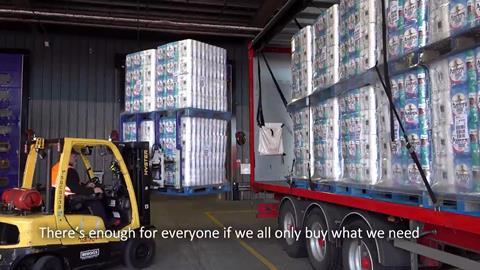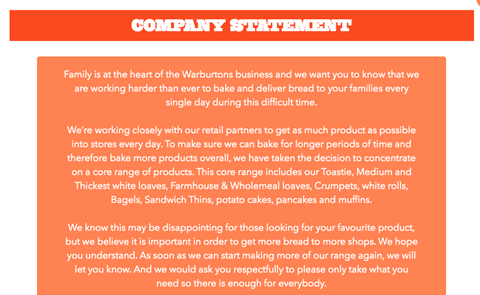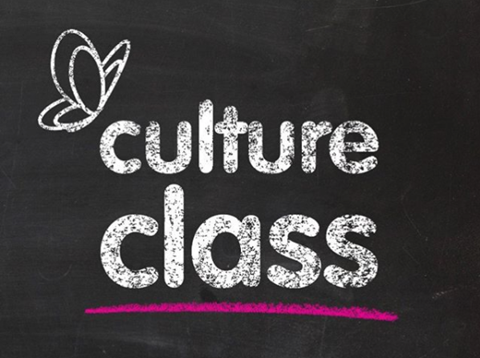Fmcg is one of the few categories expected to keep communicating with shoppers in the Covid-19 crisis. But how to avoid seeming opportunistic or crass?
”Where to even begin.” That’s how One Water, the ethical water brand, kicked off a post shared on its Twitter account last week. “We know we’ve been a little quiet, but we’ve been struggling to think of what to say amidst this strange time,” the brand said.
It’s a sentiment that will resonate with many brands. As coronavirus continues to wreak havoc, they are desperately trying to figure out how to stay visible and relevant without coming off as crass or opportunistic.
So what is the right approach right now? Should brands still communicate and advertise? Is it worth pushing NPD? Or is it best to batten down the hatches and focus on production and availability?
To date, many fmcg brands have chosen to stay silent. Analysis by The Grocer suggests that, as of 29 March, just 24 of the UK’s 100 biggest grocery brands had acknowledged the coronavirus outbreak in any form on their consumer-facing websites, and only a third had referred to the crisis on Instagram or Twitter.
That’s not necessarily a problem. “Some brands shouldn’t communicate,” says Rob Metcalfe, chairman of Richmond & Towers. “If you haven’t got anything to say that is supportive, don’t say it.”
Laurra Davis, founder and creative director at Brilliant Agency, agrees. “Not every brand can do something about this. Not every brand can give to charity or support the NHS. Those are the ones that can be silent and perhaps that’s the best thing to be doing at the minute.”
Certainly, silence is better than communicating as if it’s business as usual, adds Davis. “The ones creating the most damage are the ones pushing out their usual content and messaging and aren’t in any way acknowledging what’s happening.”
“If you haven’t got anything to say that is supportive, don’t say it.”
For brands that are choosing to communicate, experts advise focusing on being useful rather than clever or funny right now. For example, brands can play a big role in educating and reassuring the public about product availability by explaining what they’re doing to ensure shelves are stocked.
“That sort of approach, which aids consumer understanding and shows you’re doing your best to make this work, is very sound,” says Metcalfe.
One of the brands doing this is Arla. The dairy co-op has created a detailed information hub on its website to explain how coronavirus is affecting milk production and its own product range.
“With dairy, particularly milk, being a staple in household fridges, we knew it was important to use our website and social media to communicate openly with consumers as we did see a natural rise in questions about people’s favourite products and their availability,” says Arla Foods UK communications director Theis Brøgger.
Brands in other categories affected by panic-buying, such as Andrex, Aptamil and Warburtons, have taken a similar approach, while Dettol maker RB has created a website, covid-19facts.com, dedicated to coronavirus information and myth-busting.
Recipe inspiration and advice on how to make the most of stockpiled supplies is also worthwhile, especially as many shoppers will have bought products that aren’t part of their normal routine or in greater quantities than usual. It doesn’t have to be anything big: Cathedral City is running a simple ‘you can freeze our cheese’ flash on its homepage.
Where campaigns have already been created, they should be sense-checked to ensure they reflect the new reality as much as possible – or at least don’t clash with it. Gressingham Duck, for example, was due to run a YouTube ad campaign ahead of Easter with the message ‘impress your family guests’. “We have changed this to be sensitive to those who may be away from their families this Easter due to social distancing measures,” says brand manager Rebecca Alderton. “It is now themed around ‘loved ones’, rather than guests.”
Crucially, none of brands’ proactive messaging around coronavirus should get anywhere close to being self-promotional. Consumers are highly sensitive right now, so anything that comes off as salesy risks reputational damage.
This can include highlighting ‘good deeds’, such as charity donations and support for the NHS. While some experts advise being vocal, Metcalfe urges caution. “This is the sort of thing that should appear on a website, but it’s not something you would tweet about. Because then it switches from something people can discover about you to something you’re using to promote yourself.”
Exploitative behaviour
Brands should be mindful of other risks too. Regulators including the ASA and CMA have made clear they will take tough action against exploitative commercial behaviour, says Katrina Anderson, an associate at law firm Osborne Clarke. “Even messaging you’ve used for a long time potentially needs to be reassessed, particularly if it’s around health,” she warns, especially claims related to the immune system.
Of course, tweaks to existing comms and campaigns are one thing. Actively launching new campaigns and pursuing PR opportunities in the current climate is quite another. Many brands say they are nervous about putting themselves out there for fear of coming off as insensitive.
“It feels like you can’t celebrate anything at the moment, while the world is in such pain,” says Barney Mauleverer, co-founder of Fuel10k. “We’ve pulled back on any good news stories for the time being. There are other things people want to read about than some brand doing something somewhere.”
That grocery is, by and large, doing better than other sectors plays a role here. “We need to be a bit careful that we don’t end up looking smug, even if we’re not actually feeling smug,” says Paul Hargreaves, CEO of Cotswold Fayre. “It can come across a bit that way. Food and drinks brands saying ‘we’re all in this together’, when, actually, we’re doing OK but lots of other people aren’t.”
“It feels like you can’t celebrate anything at the moment, while the world is in such pain”
Despite this, there are PR opportunities out there – and with many titles reporting record traffic it can be a good time for brands to be in the media.
B2B publications such as The Grocer are still happy to be pitched stories, while stockpiling has created new opportunities in the national media around how food and drink is produced, and investment in production.
It’s also still worth pitching product stories to consumer titles, adds Alex Godfrey, founder of Right Hand PR. “Many journalists on monthly print titles are working completely as normal,” she says. “And they’re actually desperate for stories. It’s almost easier to land product stories with them at the moment because a lot of people have backed down on PR.”
Read more: How to pitch stories to The Grocer right now
Not that every brand is in a position to release product stories right now. With consumers distracted by the incessant news cycle, trade shows cancelled and supply chains under strain, lots of NPD plans are being put on the backburner.
Smaller brands in particular are choosing to press pause on costly – and potentially risky – innovation in favour of shoring up their core business.
Protein water brand Vieve was due to launch a new flavour as well as a vegan version of its product later this year, but is putting the money into additional production instead. “There’s lots of strain on supply chains, so we don’t want to be caught out,” says founder Rafael Rozenson. “At the moment, there’s lots to be gained just by being able to supply reliably.”
New products and flavours are also on hold at The Great British Porridge Co. “This is because of delays to the new packaging and the fact that we need to focus on our existing lines to ensure we keep all stores, including Sainsbury’s and Waitrose, stocked up,” says founder Jacqueline Barleycorn.
Elsewhere, NPD for export markets has taken a hit: Wyke Farms has moved back the launch of a brand developed for the Asian market, until the peak of the pandemic has passed. “There are longer-term projects for the Wyke Farms and Ivy’s Reserve brands that are in early-stage development and these are unaffected,” adds MD Rich Clothier.
Others plan to focus their NPD efforts on seasonal events such as ‘back to school’ and Christmas, which many expect to be larger than usual this year.
“Christmas will be huge,” says Hargreaves. “If a small brand came to me and asked what they should be doing for NPD, I’d say focus on Christmas. Forget the summer and get some good Christmas lines ready, so as soon as this is over you’re ready to go.”
Even where NPD is still scheduled to go ahead, brands are being cautious in their communications. Tony’s Chocolonely is going ahead with plans to bring out a new flavour in June, but UK country manager Ben Greensmith says he’s mindful about not pushing the brand’s ethical message too hard. “We have to make sure people are open to being confronted with the realities of the chocolate industry,” he says. “Now is just not the right time for us to be talking about what we stand for.”
Trade comms
Similar caution applies to trade comms. Nobody wants to be the brand hassling buyers for listings or range review updates at a time when they’re trying to feed the nation.
“We don’t want to put them under any pressure by pushing new products,” says Shirley Peet, marketing manager at distributor Robinson Young. “We want to work with them and be supportive right now, so when we come out of this at the other end we’re seen much more as colleagues than suppliers.”
However, that’s not to say you shouldn’t talk to buyers. “We’re all experts at Zoom,” says Asda CEO Roger Burnley. “Do not think you are bothering us. In no way. We need to overcommunicate, not undercommunicate.” But the focus should be on helping, not selling. “It’s about working out how to help produce more of what matters and less of the peripheral. Simplify what you give us. Suggest whole pallets, bigger pack sizes, a box already made up of key essential items, rather than one SKU, perhaps in conjunction with other suppliers. How efficient would that be? Get creative.”
And brands won’t have to wait until the outbreak is over before they can accelerate their comms efforts again. As soon as we’re over the peak and attention shifts to the period after the crisis, they can be bolder, says Metcalfe. “That’s when brands can start to be positive and talk about their role in the future and their NPD.”
It’s a thought to hold on to as we navigate this exceptionally difficult period. Those who approach their comms with care, integrity and purpose right now are likely to emerge from the crisis with the credibility they’ll need to thrive in the post-Covid-19 world.
Five examples of strong coronavirus comms

Andrex
Toilet paper has been one of the most stockpiled items during the coronavirus crisis, putting pressure on brands to reassure shoppers about supplies and keep them informed. Andrex led the charge with a video distributed via its social media channels, showing toilet paper being produced, packaged and loaded on to lorries at its Northfleet mill in Kent. The mill is “running at full capacity 24/7”, the video informs shoppers, and “there’s enough for everyone if we all only buy what we need”. The brand has also added a video banner to its consumer-facing website telling visitors its UK mills have accelerated production to ensure “everyone has what they need”.

Innocent
A global pandemic should be nightmare material for a brand renowned for its tongue-in-cheek tone of voice, yet Innocent’s social media team is making it work with a humorous, on-brand take on WFH culture. From a new Twitter bio (“We make healthy drinks and are currently working from home”), cheeky tweets offering a “daily reminder of what day it is today”, nonsensical Instagram crosswords to help pass the time and a list of 100 things to do inside this weekend (“use the nutritional information on your canned goods as a makeshift version of Top Trumps”), it’s an approach that gently acknowledges what’s happening in the world without ever being crass.

Aptamil
These are worrying times for parents, so Aptamil has created a Covid-19 information hub covering everything from product availability to WHO guidance on coronavirus risk to babies. A myth-busting section corrects common misconceptions, while a section on stress gives advice on how to calm an anxious child, as well as manage your own stress levels. The brand is also reassuring parents it’s OK to switch to rival brands if they can’t buy their usual Aptamil product: “You can use most infant milks labelled suitable from birth from any manufacturer in powder or liquid form. […] If you decide to change your formula product, it is completely safe for you to do so immediately.”

Warburtons
Warburtons has been leading the bread category’s coronavirus communications efforts with accessible, easy-to-understand information about how it’s responding to the crisis. Visitors to the Warburtons website are greeted with a prominent pop-up message from chairman Jonathan Warburton, reassuring shoppers and explaining why the company decided to reduce its product range to maintain availability on core lines. “We believe it is important in order to get more bread to more shops,” the note reads. Similar messages were distributed via Instagram. On Twitter, meanwhile, the brand has been highlighting its support for and donations to the NHS.

Arla
With detailed information about coronavirus’s impact on milk production, dairy supply chains and product ranges, the Covid-19 section on the Arla website is among the most comprehensive in fmcg. It was created after the dairy co-operative’s consumer relations team saw a 60% increase in enquiries, says communications director Theis Brøgger. “Publishing clear, transparent information as to what was happening at Arla enabled the public to readily access answers to the key questions around availability, easing the pressure on our teams and reducing frustrations that may have otherwise occurred from those seeking information.”
Last man standing in adland?
“From April and until further notice, we’re putting commercial advertising for Coca-Cola and all our brands on hold.”
So said Coke in late March, when it announced it would focus instead on ensuring “the safety and wellbeing of our communities and people” and donate $120m to Covid-19 relief efforts.
Coke isn’t the only fmcg brand to make dramatic changes to its advertising spend in light of coronavirus. In the US, AB InBev said it would divert its sports and entertainment budget to non-profit organisations. Many others have frozen campaigns while they assess their options.
Despite these high-profile announcements, fmcg is in many ways “the last man standing” in adland, suggests Carl Carter, head of media and connected consumer at IRI. “There’s a lockdown on a lot of verticals, but in fmcg at this point there is still spend,” he says. “That’s because there is still opportunity and people are still buying.”
Others echo this. While it’s early days and robust figures are hard to come by, a recent snapshot survey by Ebiquity suggests fmcg – along with healthcare and telecommunications – is among the sectors expected to reduce advertising spend the least.
“Our first instinct was knee-jerk: freeze everything”
Areas such as outdoor advertising, experiential, shopper activation and trade promotions have obviously been hit, but spend is in many cases being redirected to other channels, such as video-on-demand or TV. Some advertisers are also using the crisis to experiment with digital and social media advertising.
“Our first instinct was knee-jerk: freeze everything,” says Tenzing founder Huib van Bockel. “But now we’re slowly looking at opportunities to be had around online sales, so we’ve been putting smaller test marketing packages around Google, Facebook and Amazon and are seeing some really good results.”
However, such experimentation isn’t yet happening on a major scale, says Carter, though he hopes to see brands become “bolder and braver”. With CPMs currently down 40%-50%, the cost is low right now and “the audience is at its biggest potentially,” he says.
For brands still willing to spend, there are also good deals to be had around sponsorship. “There are deals appearing that you wouldn’t have seen a while ago simply because people aren’t committing to them,” says Chris Blythe, director at The Brand Nursery.
All in all, it pays for brands to be “a bit brave”, adds Carter. “They have to push forward. Of course they should use every piece of data that exists to make that right decision, but fundamentally you can’t tiptoe.”

How social media is helping brands stay relevant
Brands cannot change a TV campaign overnight or pull magazine ads that went to press weeks ago – but they can use their social media channels to reflect what’s happening right now and respond to shopper enquiries in real time.
This can include some rather sensitive matters. At distributor Robinson Young, whose brands include Ace stain removal products, marketing manager Shirley Peet has had to field questions about whether it’s OK to wash your hands in bleach. Meanwhile, Fever-Tree has been putting out tweets advising punters the quinine in its tonic waters cannot protect against Covid-19, after anti-malaria drugs containing quinine made headlines as a possible virus treatment.
In general, however, many fmcg brands have been quiet on social. Analysis by The Grocer suggests that, as of 29 March, just 33 of the 100 biggest grocery brands had been using Twitter to communicate about coronavirus, and 35 of the top 100 had been using Instagram.
Smaller brands have been more proactive. Itsu Grocery, for example, has launched ‘culture classes’ on Instagram Stories. The classes run three times a week at 10am – straight after Joe Wicks’ online PE class – and teach children and families about Asian culture. “We had to have a real think about what we do on social media,” says head of marketing Natalie Sugarman. “How do we add value and not just do comms for comms’ sake?”
Others have made small but important tweaks. Healthy cakes startup Fitbakes has adapted its usual recipe and workout content to reflect that people are working out at home and want ideas for store cupboard staples. “We’re not doing anything massively different,” says founder Ella Rauen-Prestes. “We just tweaked what our audience is already used to getting from us.”
There are other steps brands can take to ensure they remain relevant. Scheduling software that automatically posts pre-planned content can trip you up, so it’s best to switch to manual scheduling or schedule posts for after midday, recommends Laurra Davis, founder and creative director at Brilliant Agency. “That way, there’s a chance after the previous day’s daily government briefing to sense-check the post one more time.”
Social media copy should also be checked for phrases such as “stock up” or anything that could be seen to encourage behaviour contrary to public health advice, says Davis.




















No comments yet